There are several benefits to playing in an online casino. Not only are you guaranteed to win, but you can get some added value. Most online casinos offer newsletters and updates to their players. However, you must make sure you understand what the terms and conditions are and that you have not missed any important information. If you do not understand the terms and conditions, you may end up losing the bonus and your winnings. In addition, online casinos often change their terms and conditions often, so you must always read the terms and conditions carefully before deciding to participate in any promotions.
When signing up for an online casino, it is important to choose one that accepts your preferred payment method. Most of the leading online casinos accept payment methods like Visa and MasterCard. While these methods may seem risky, they allow you to deposit with your credit card. If you prefer a different method, you can also use an e-wallet to make payments. This is also convenient for those with low monthly budgets. Besides, using a credit card is a safer option than using cash.
There are several advantages of playing in an online casino. Online casinos are easy to use and offer a great chance to win money. Unlike a land-based casino, an online casino can be trusted. The games are safe and very fair, and you can be sure that your money is safe. Despite this, some people are hesitant to play online for real money. This article will provide some information and explain the advantages of playing in an online casino.
Legality. While some Americans cannot play online, some states are considering changing their laws regarding gambling. The recent legislation regarding sportsbooks and casinos has opened the door for these businesses. Although it is difficult to predict the legality of online gambling, the future of the iGaming industry looks bright. If the current legislation continues, online casinos will soon follow sportsbooks in popularity. However, the legality of online gambling remains a concern for many consumers.
RNGs. Random number generators (RNGs) are critical to the integrity of online casino games. Random numbers are used to determine the outcome of each bet. The RNGs used by online casinos are audited regularly to make sure that they maintain the correct odds. If the odds are low, the result is fair. In some cases, the payout is delayed or even cancelled altogether. Hence, online casinos often pay out winnings only after paying their customers.
Variety of games. BitStarz offers thousands of games and more. However, compared to other online casinos, this one is more flexible and has a wide variety of slot machines. Moreover, customers can play at their own pace. Instead of waiting for other players to finish playing, online casinos move forward at a faster pace. This means that more games can be played in less time. However, this doesn’t mean that an online casino is not regulated by any jurisdiction, but it must be safe to play and abide by their rules.





































































































































